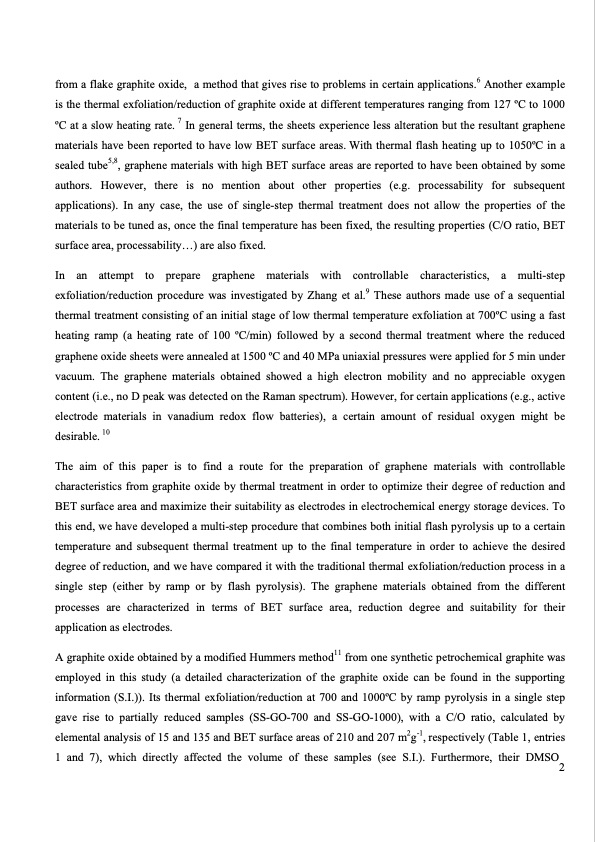
PDF Publication Title:
Text from PDF Page: 002
from a flake graphite oxide, a method that gives rise to problems in certain applications.6 Another example is the thermal exfoliation/reduction of graphite oxide at different temperatures ranging from 127 oC to 1000 oC at a slow heating rate. 7 In general terms, the sheets experience less alteration but the resultant graphene materials have been reported to have low BET surface areas. With thermal flash heating up to 1050oC in a sealed tube5,8, graphene materials with high BET surface areas are reported to have been obtained by some authors. However, there is no mention about other properties (e.g. processability for subsequent applications). In any case, the use of single-step thermal treatment does not allow the properties of the materials to be tuned as, once the final temperature has been fixed, the resulting properties (C/O ratio, BET surface area, processability...) are also fixed. In an attempt to prepare graphene materials with controllable characteristics, a multi-step exfoliation/reduction procedure was investigated by Zhang et al.9 These authors made use of a sequential thermal treatment consisting of an initial stage of low thermal temperature exfoliation at 700oC using a fast heating ramp (a heating rate of 100 oC/min) followed by a second thermal treatment where the reduced graphene oxide sheets were annealed at 1500 oC and 40 MPa uniaxial pressures were applied for 5 min under vacuum. The graphene materials obtained showed a high electron mobility and no appreciable oxygen content (i.e., no D peak was detected on the Raman spectrum). However, for certain applications (e.g., active electrode materials in vanadium redox flow batteries), a certain amount of residual oxygen might be desirable. 10 The aim of this paper is to find a route for the preparation of graphene materials with controllable characteristics from graphite oxide by thermal treatment in order to optimize their degree of reduction and BET surface area and maximize their suitability as electrodes in electrochemical energy storage devices. To this end, we have developed a multi-step procedure that combines both initial flash pyrolysis up to a certain temperature and subsequent thermal treatment up to the final temperature in order to achieve the desired degree of reduction, and we have compared it with the traditional thermal exfoliation/reduction process in a single step (either by ramp or by flash pyrolysis). The graphene materials obtained from the different processes are characterized in terms of BET surface area, reduction degree and suitability for their application as electrodes. A graphite oxide obtained by a modified Hummers method11 from one synthetic petrochemical graphite was employed in this study (a detailed characterization of the graphite oxide can be found in the supporting information (S.I.)). Its thermal exfoliation/reduction at 700 and 1000oC by ramp pyrolysis in a single step gave rise to partially reduced samples (SS-GO-700 and SS-GO-1000), with a C/O ratio, calculated by elemental analysis of 15 and 135 and BET surface areas of 210 and 207 m2g-1, respectively (Table 1, entries 1 and 7), which directly affected the volume of these samples (see S.I.). Furthermore, their DMSO2PDF Image | TUNING GRAPHENE MULTI-STEP THERMAL REDUCTION PROCESS

PDF Search Title:
TUNING GRAPHENE MULTI-STEP THERMAL REDUCTION PROCESSOriginal File Name Searched:
36194253.pdfDIY PDF Search: Google It | Yahoo | Bing
Salgenx Redox Flow Battery Technology: Power up your energy storage game with Salgenx Salt Water Battery. With its advanced technology, the flow battery provides reliable, scalable, and sustainable energy storage for utility-scale projects. Upgrade to a Salgenx flow battery today and take control of your energy future.
| CONTACT TEL: 608-238-6001 Email: greg@infinityturbine.com | RSS | AMP |